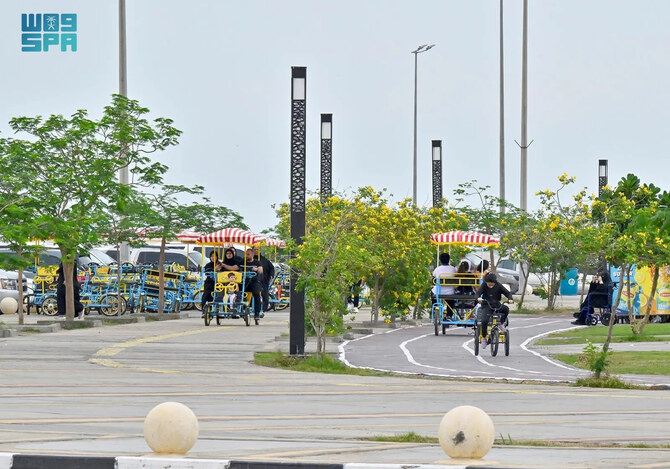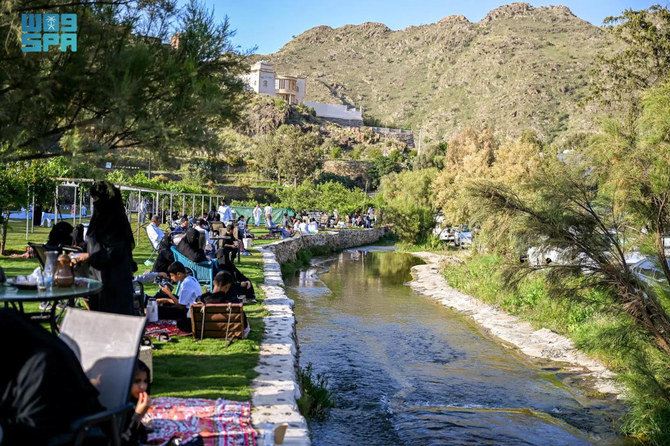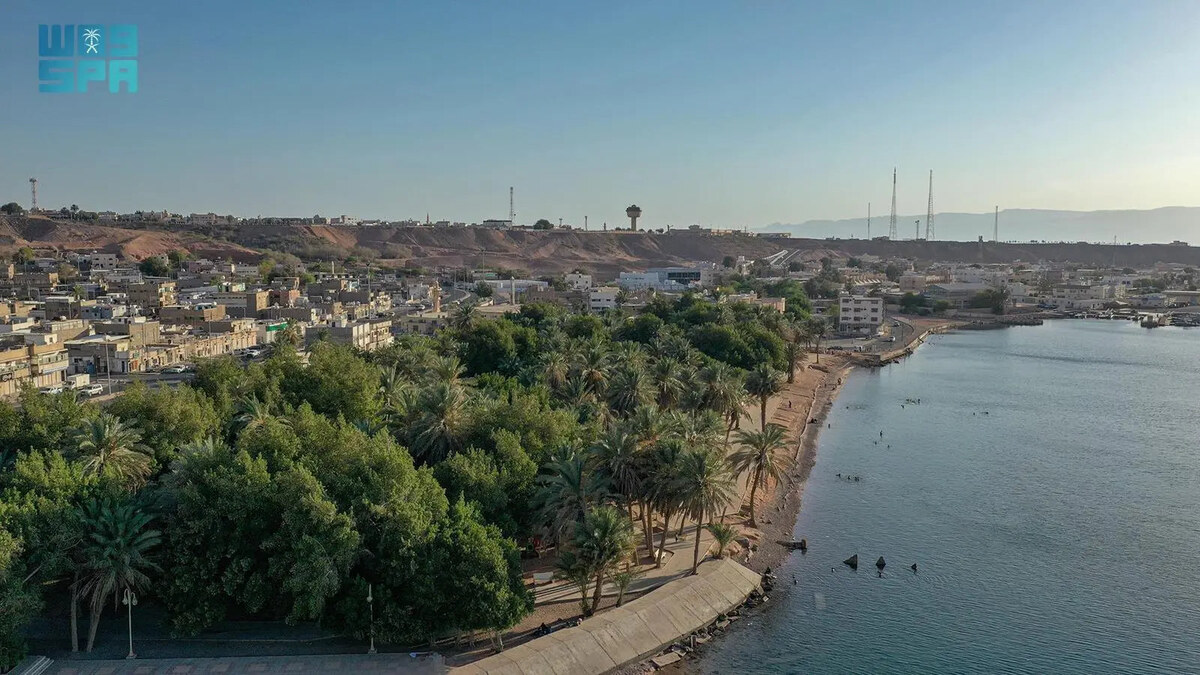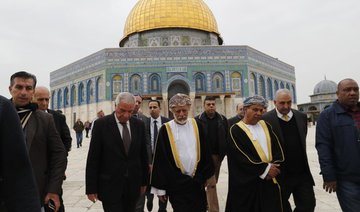MITZPE RAMON, Israel: Israel has already been credited with making the desert bloom. Now it hopes to make it boom — with tourists.
Seeking to bolster tourism to its vast and largely undeveloped Negev desert region, Israel is promoting luxury camping trips, Bedouin hospitality and challenging outdoor activities like dune surfing.
In addition, a new international airport is rising from the desert floor 18 kilometers (11 miles) from the Israeli Red Sea resort of Eilat and the neighboring Jordanian port of Aqaba.
Tourism in Israel is big business, bringing in $5.8 billion in 2017.
Arrivals to the country of about eight million citizens hit a record 3.6 million last year, the Israeli tourism ministry said.
The United States, Russia, France, Germany and Britain accounted for most of the visitors.
The ministry says that it now seeks to grow the Negev’s share of total Israeli tourist revenue from the present five percent to 20 percent within two to three years.
It also aims to increase the number of Negev hotel rooms from 2,000 to about 5,000 within six to seven years.
Israel is marketing the desert as a unique destination on Europe’s doorstep.
“When it’s very cold in Europe, let’s say in December, January and February, we have very mild temperatures in the Negev,” the tourism ministry’s Uri Sharon told journalists on a tour of the sparsely populated region.
Activities include hiking, biking, rock climbing, abseiling and dune surfing — akin to snowboarding on sand.
The Negev is also home to a geological marvel: the Ramon Crater, the world’s largest erosion crater.
Salaam El Wadj has opened up the encampment where he lives with his wife, children and goats to visitors, who can stay in one of the tents and listen to his stories of Bedouin life.
“I was born here in the Negev hills,” he tells his visitors over strong, sweet tea.
Wadj relates how the arrival a century ago of British and French administrators and, in 1948, officials of the new state of Israel, brought a drive for modernization that disrupted and threatened the nomadic Bedouin way of life.
Hosting tourists, he said, enables him to preserve his heritage.
“They don’t want to just sleep in a Bedouin camp but also to learn,” he said.
Hikers can walk along part of the Negev Highland Trail, covering about 12 km a day between Bedouin camps while their luggage is transported by vehicle.
Near Wadj’s site, Hannah and Eyal Izrael have planted vineyards on terraces where Nabatean farmers cultivated vines 2,000 years ago.
Their Carmey Avdat winery produces just 5,000 bottles a year of Merlot, Cabernet Sauvignon, Chardonnay and other wines.
Eyal supplements his income by offering tourist accommodation in cabins and group tours to surrounding sites of interest rather than industrializing his winemaking.
Visitors can help run the production line and bottle, cork and label their choice of wine personally.
“All the time there are tourists from all over the world coming to the Israeli desert to explore, trek, taste our wine, go to other farms to taste goat cheese,” he said.
“The Negev is a very safe and accessible desert and it’s warm here.”
The vines grow in a natural basin, watered in winter by runoff from the surrounding hills and augmented with a modern irrigation system fed by desalinated sea water piped from the Mediterranean coast.
Not far from Carmey Avdat is the town of Mitzpe Ramon, which stands at the edge of the Ramon Crater.
There, travelers after tranquility with a luxurious twist can go “glamping” — glamor camping — in luxury tents with hot showers and a personal chef.
When inky night falls over the crater’s floor, there is the option of gazing through high-powered telescopes at the stars shining brightly in the unpolluted sky.
The Negev’s heart is only about a two-hour drive from Israel’s main international airport near Tel Aviv.
The new Ramon Airport will bring jumbo jets from around the globe to the desert itself.
Its website says that it will be able to initially handle up to two million passengers annually, but will be able to expand to a capacity of 4.2 million by 2030.
Low-cost and charter airlines currently flying to Ovda airport, about 60 km away from Eilat, will move to Ramon, it says.
They include Ryanair, Wizz Air, easyJet, SAS, Finnair and Ural Airlines.
Construction began in May 2013.
Israeli media say that the airport is expected to start operations this autumn, in time for the November-May winter tourist season, but the Israel Airports Authority (IAA) is making no official forecasts.
The IAA says the original specifications for the project were revised in light of lessons learned during the 2014 Gaza war.
After a rocket fired by Hamas militants in Gaza hit near the perimeter of Tel Aviv’s Ben Gurion International Airport, international carriers suspended flights.
IAA spokesman Ofer Lefler said that the revised plans for the Ramon airport will allow it to serve as a backup in addition to boosting tourism.
“In an emergency, not only will Israel’s entire passenger air fleet be able to land and park there, but also additional aircraft,” he said.
Seeking tourists, Israel promotes a different sun and sand
Seeking tourists, Israel promotes a different sun and sand

Virtual, AI-powered Saudi travel companion impresses visitors at travel exhibition in London

- The new app, called SARA, offers users insights and advice about the Kingdom’s tourist attractions in a natural and seamless conversational style
RIYADH: The Saudi Tourism Authority unveiled the beta version of SARA, its new travel companion app for visitors to the Kingdom, at the World Travel Market exhibition in London this week.
It allows users to interact with a digital female guide, powered by AI, who is deeply knowledgeable about Saudi Arabia and offers insights and advice about the country’s tourist destinations, historical landmarks, archaeological sites, cultural diversity, international events, and anything else a visitor might be interested in.
SARA was on show in the Visit Saudi pavilion at the World Travel Market, which began on Monday and concluded on Wednesday. Officials said she interacted directly with attendees, who were captivated by her engaging stories about the Kingdom’s tourist attractions and experiences, and the extensive information she was able to provide.
The app reflects the nation’s progressive approach to smart tourism, they added, and leverages the latest developments in AI so that it can respond to questions, understand visitor needs, and offer personalized information and suggestions in a natural and seamless conversational style.
Off the beaten track in Sri Lanka

- New visa rules have made it easier than ever for Gulf tourists to visit the island nation
TORONTO: Sri Lanka has long been a favored destination for visitors from the Gulf. Easy access, budget-friendly offerings, and diverse experiences – from cultural and historic landmarks to idyllic beach resorts and scenic treks – make it an ideal getaway destination. And now, there’s one more reason for Saudis to take a trip to the island nation. Last month, the Sri Lankan government announced that residents of Saudi Arabia, the UAE, Qatar, Oman, and 31 other countries can now visit without a visa.
The capital, Colombo, is probably the most popular destination in Sri Lanka, along with Kandy and Ella, but the less-frequented areas in the central and southern regions of the country are well worth considering.

My Sri Lanka trip started in Hatton, in the Nuwara Eliya region. Often called “Little England,” the region is a reminder of the country’s former colonial rule, with Tudor-style architecture and sprawling tea estates named after their former British proprietors.
The central province is home to Sri Lanka’s renowned tea highlands. Tea is an integral part of the island’s history and culture — as its former name, Ceylon, suggests.
My encounter with Ceylon tea starts at the Dunkeld Tea Factory, owned by The Dilmah Group, a family-run business that has become a global name. The tea is single-origin — meaning it is picked, cultivated, and packed from the lush, rolling terraces of the region. The tour takes guests through the history of Ceylon tea, which actually began with coffee plantations in the 18th century. But leaf disease devastated those plantations, leading to the demise of the short-lived coffee industry in Sri Lanka. In 1867, James Taylor, a Scottish man, planted the first tea clearing in Kandy. By the late 19th century, the country had become one of the largest tea producers in the world. Guests are also invited to a tea-tasting experience, including the Orange Pekoe, the robust tea blend that is a specialty of the region.

I stayed at Summerville, one of the five palatial bungalows once home to English plantation owners which have now been refurbished into boutique properties by the Ceylon Tea Trails Hotel under the Resplendent Ceylon Group. Perched at nearly 4,000 feet and set across 2,000 hectares, the bungalows are perfect for those seeking a slow, luxurious vacation. Guests can enjoy breathtaking panoramic views of the emerald hilltops from various vantage points or unwind in the several tranquil lounge spaces scattered throughout the bungalows. Or — with a private chef and butler on hand — choose to indulge in a five-course dinner that features the likes of a Yatawatte tea-infused roasted chicken or the Earl Gray fondant.
The tea trails, ranging from four to 15 kilometers long, connect the various bungalows, offering scenic hikes through the valleys. For those seeking adventure, the newly-inaugurated Pekoe Trail (a 300-km route with 22 phases) allows tourists to explore the rich biodiversity of the area. This trail can be experienced on foot or by rail.

The next leg of my trip was drastically different. As we were making our way down from the central region to Sri Lanka’s southern tip, the hilltops, winding roads, and cool weather gave way to palm trees, speedy tuk-tuks, and tropical weather.
In the Hambantota district, the biggest draw is undoubtedly Yala National Park, the second largest national park of the country, and the one with the highest density of leopards. An early morning or afternoon game drive provides ample opportunities to spot wildlife, including the elusive leopard, sloth bears, and elephants.
After the adrenaline rush of a wildlife safari, I head to our ‘glamping’ lodge — the Wild Coast Tented Lodge, another one of Resplendent Ceylon’s properties. The luxury camp is unfenced and wildlife will often wander into the premises from the park, giving guests a sometimes-gleeful, sometimes-terrifying experience.
The lodge itself is an architectural delight, focusing on sustainable design and the use of organic materials, including bamboo. It includes 28 “cocoons” or pods scattered throughout the jungle wilderness. The interiors feature rustic touches like cooper hardware, a leopard-claw bathtub, and vintage leather furniture.
It’s also here that the jungle meets the Indian Ocean. As I wandered along the rugged coastline or enjoyed a sundowner, I was once again reminded of the serenity that Sri Lanka has to offer.
Saudi Arabia’s recreational spaces ready for holiday season

AL-BAHA: Saudi authorities have announced extensive preparations of public recreational facilities ahead of the school holiday season.
The Al-Baha municipality has readied 142 parks and recreational areas, along with municipal squares, public spaces and streets, to welcome visitors and tourists.
According to regional secretary, Ali bin Mohammed Al-Sawat, these facilities span more than 4,188,559.98 million square meters and feature amenities including children’s playgrounds, green spaces, shade structures, lighting, sidewalks, seating areas and parking, and facilities for activities such as walking and cycling.

Meanwhile, the Eastern Region Municipality has completed the preparation of 979 parks and public squares, 18 public recreational parks, 14 waterfront areas and 213 walking tracks.
The facilities are timely as moderate weather conditions and school breaks attract more outdoor activity.
The municipality emphasized its commitment to regular maintenance of these facilities, considering them vital breathing spaces for citizens and residents.

Cloud7 Residence AlUla: A dreamy home away from home

- The gated resort is an ideal place from which to explore the ancient desert oasis
ALULA: Roughly half an hour’s drive from AlUla’s Prince Abdul Majeed bin Abdulaziz International Airport, Cloud7 Residence is the largest hotel in the area, boasting 301 modern bungalows. Each unit is thoughtfully designed, featuring individual private terraces from which guests can enjoy awe-inspiring views of AlUla’s stunning landscapes — mountains and lush greenery.
Cloud7’s decor blends the ancient with the trendy. Coupled with the traditional Saudi hospitality on offer, this is a truly nice place to stay. It’s the chillest hotel/resort I’ve been to in ages.

The beds are comfortable and the rooms are well-equipped, including plenty of places to plug in your devices. There are eco-friendly products provided, including chewable toothpaste that comes in tiny pills in a glass jar, and which activates once you have some water in your mouth.
The fridge comes stocked with complimentary sodas and plenty of water bottles at the ready — also useful for feeding into the coffee machine.
The main mode of transportation in the grounds, whether taking your luggage to your room, going to breakfast or to relax by the pool, or heading to your next activity, is a buggy. There was usually one right outside my door each time I emerged from my bungalow, but if there isn’t, you can simply call for one.

The residence is an ideal base for both short- and long-term stays, designed to accommodate the needs of leisure seekers, adventure enthusiasts and business travelers alike in its secure, gated space.
As part of the residence’s commitment to honoring local heritage, a series of murals created by local artists adorn the walls. Artists including Hanan Sami and Maram AlSelayem brought their individual styles to the project, creating pieces that highlight AlUla’s natural beauty and heritage. The venue’s community and culture manager, Fahad Alfaqir, said the artists who painted the murals are all from AlUla, as he is, and that they depicted local plants and flowers to decorate the spaces and used inscriptions from indigenous languages.
Cloud7 Residence AlUla’s dining experiences range from gourmet meals to relaxed, family-friendly options. Charcood, the resort’s signature restaurant, offers a selection of smoky, charcoal-grilled dishes crafted by Chef Jaume Puigdengolas. Open for breakfast, dinner, and light bites, it was my go-to place to start the day.

For those who prefer a more casual atmosphere, Off-Road Café serves lunch, dinner and light snacks in a laidback setting, perfect for watching live sports or movies on large screens. Guests can enjoy playing pool, darts and foosball, or indulge in some shisha outside.
For those seeking a relaxing time away from being away, the Pool Lounge offers casual dining with comfortable beanbags and a curated menu of international flavors, all presented poolside. It was perhaps my favorite spot to sit and literally reflect while the serene water reminds you to stay centered.
Cloud7 Residence AlUla is also in a prime location for exploring AlUla’s many historical sites. Visitors can easily reach attractions like the ancient city of Dadan, Jabal Ikmah’s rock inscriptions and — my favorite — Old Town. You can book guided tours, but the hotel also provides car and bike rentals.
Cloud7 Residence AlUla is more than just somewhere to stay; it’s an invitation to connect with the timeless beauty of AlUla — a place which makes you feel so big and so small all at once.
Tashkent: An underrated gem of the Silk Road

- Uzbekistan’s capital city boasts grand architecture and a rich cultural history
DUBAI: Tashkent may not be as famous for its architecture and culture as Paris, Rome or Barcelona, but the capital of Uzbekistan is an underrated gem for tourists.
With a population of more than three million, Tashkent is the largest city in Central Asia, which was formerly part of the Soviet Union. Tashkent — which means “city of stone” — is historically significant as one of several trading hubs (along with its neighboring cities Bukhara and Samarkand) on the Silk Road stretching from Europe to China. In the 8th century, the city was under Muslim Arab rule, and Islamic architecture, studded with stunning blue tiles that match the skies above Tashkent, remains a notable feature.
Under Soviet rule, Tashkent saw a rise in the modernist style of heavy, brutalist buildings beloved by the USSR — see, for example, the overwhelming, grid-like exterior of Hotel Uzbekistan, established in 1974. Between the 1960s and 1990s, such structures were part of a plan to rebuild the city after an earthquake in 1966.

One of the grandest buildings in Tashkent is the centrally located Alisher Navoiy Theater, an elegant opera house which opened in the 1930s, playing the timeless melodies of classical maestros Tchaikovsky, Prokofiev and Verdi. It is named after the poet and national hero dubbed “the father of Uzbek literature,” who was born in modern-day Afghanistan during the 1400s. Designed by the Soviet architect Alexey Shchusev, the 1,500-seat opera house radiates with European and Oriental stylistic elements. Its six lobbies are named after the Uzbek cities of Bukhara, Khorezm, Samarkand, Fergana, Termez and Tashkent.
A number of museums — devoted to history, art, geology and warfare — exist in the capital; one of the best is the highly ornate Museum of Applied Arts, which pays tribute to the delicate handcraftsmanship of traditional Uzbek artisans, and displays embroidery, pottery, miniature paintings, jewelry and weaponry. The building itself is a work of art too, showcasing detailed wooden ceilings rendered with floral and geometric motifs.
There are more than 2,000 mosques in Uzbekistan and one of its oldest is Kukeldash Madrasah, founded in the 1500s. The tranquil site, which has been restored and used for various purposes over the years, was originally built to host lessons in Islamic studies and the Qur’an (lessons which still happen today). It also houses an intimate calligraphy studio. The main facade features Arabic scripture and a pattern of arches, decorated by predominantly blue mosaics.
Close by is the lively and substantial Chorsu Bazaar, where locals go to shop for food, spices, crockery and trinkets. The ruby-colored pomegranate fruit is particularly popular, and also features as a motif on clothing, acting, in a way, as a symbol of the country. The bazaar sits under a blue ornamented dome, which was designed in 1980.

If you’re looking for a more peaceful location, then the Rakhimovs Ceramic Studio is the place to be. This haven of creativity, accessible by appointment only, aims to preserve the heritage of ceramic art. Full of decorated pottery pieces, the family-run space tells the story of four generations of ceramic masters, starting with one of Tashkent’s prominent 20th-century ceramicists and restorer of mosaics Mukhitdin Rakhimov down to his grandson, Alisher Akbarovich Rakhimov, who has passed along the art of pottery to his son, Shokhrukh.
And Tashkent’s attractions are not all on its surface. Be sure to visit the Tashkent Metro, which, in 1977, became the first subway system in Central Asia. Its 29 stations resemble art galleries, full of sophisticated columns, patterned domes, colorful tiles and murals with stories of national pride to tell. Perhaps the most famous station in the system is Kosmonavtlar (Cosmonauts), with its blue-and-white interior that inspired by the ‘space race,’ which occurred between the 1950s and 1970s. The walls of the station showcase large medallions depicting the Soviet Union’s leading astronauts, Yuri Gagarin and Valentina Tereshkova, respectively the first man and woman to go to space.

Tashkent is an ideal location for lovers of architecture who want to discover something atypical. It has a visually appealing landscape of old and modern buildings, demonstrating the city’s diverse cultural heritage, which is worthy of preservation and attention.















